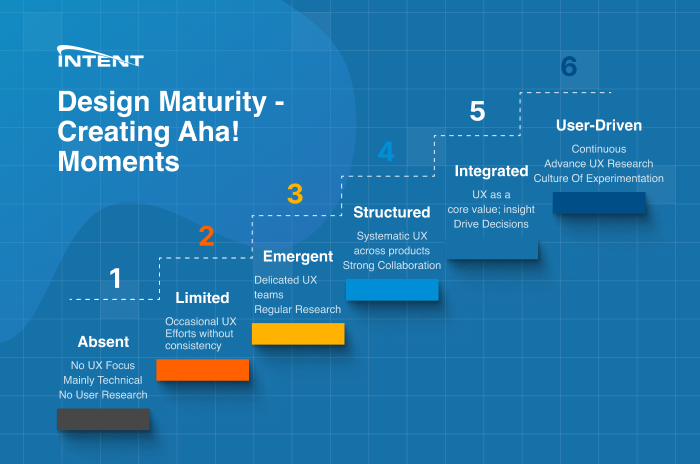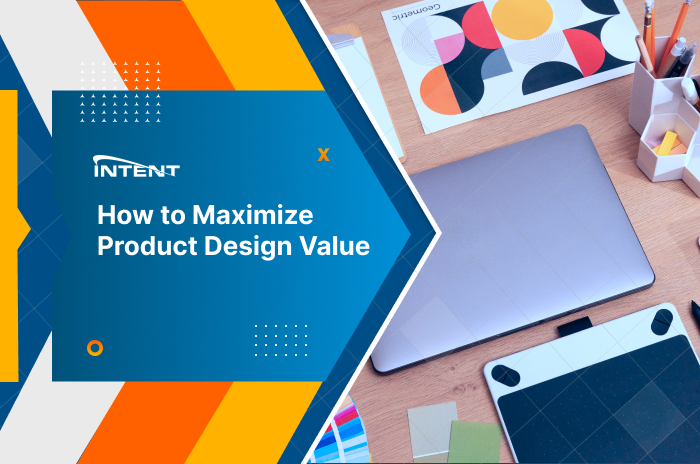Increase Sales with Improved Product Design

Customers are spoiled by choice, and their expectations for product experiences that delight are skyrocketing. The impact of thoughtful product design on revenue is indisputable, as Forrester reveals a whopping 9,900% ROI for every dollar invested in product design.
Nielsen Norman Group confirms that digital products with intuitive designs boast 30% higher conversion rates than cluttered ones. McKinsey reports that design-focused organizations experience a 21% revenue growth advantage over their counterparts.
The impact of product design transcends mere conversion metrics. A meticulously crafted product creates Aha! Moments with product users that can double, triple, or quadruple retention rates.
The Blueprint: Product Design Strategy
Product design's value proposition extends far beyond aesthetics and usability. It encompasses the entire user journey, from initial product interaction to post-purchase engagement. A seamless, intuitive design attracts prospects and nurtures lasting relationships. Notably, 72% of users with positive experiences actively advocate for the brand, creating a powerful cycle of referrals and new acquisitions.
Moreover, remember that most users will pay a premium for an exceptional product experience. To create a product design strategy that truly sets your business apart and drives revenue growth, you must go beyond generic best practices and explore the principles and logic behind effective user-centric design.
Let's explore three key strategies to help you create a product design strategy that resonates with your users and helps to ensure Aha! Moments:
Empathize with users to align product design goals and objectives.
Take the time to immerse yourself in your users' world, understand their motivations, and identify their challenges. One practical approach is to conduct contextual inquiries, where you observe users in their natural environment and gather insights into their behavior and thought processes. By understanding your users holistically, you can create experiences that meet their needs and align with your business goals.
For example, suppose you're designing a business operations application. In that case, your product design strategy should create a seamless and intuitive experience that drives more usage and higher productivity since the alternative would be manual processes or time spent circumventing the product. By understanding your users' habits, preferences, and pain points, you can design features and interactions that guide them toward conversion while providing value and satisfaction.
Optimize product design by reducing complexity and enhancing user interactions.
To create a product design strategy that drives engagement and revenue, you must focus on simplifying and streamlining the user experience. This involves reducing cognitive load and eliminating unnecessary friction points. One fundamental principle to follow is Hick's Law, which states that the time it takes for a user to make a decision increases with the number and complexity of choices.
By simplifying your interface and presenting users with clear and intuitive options, you can reduce cognitive load and guide them toward desired actions. Another important aspect is to ensure consistency and familiarity in your design. Using consistent visual elements, interaction patterns, and terminology creates a sense of familiarity and reduces your users' learning curve.
Your product design strategy should focus on creating a clear and intuitive navigation structure, providing relevant product information, and streamlining the business actions you need the user to take. Reducing the steps required and providing clear calls to action can increase conversion rates and drive revenue growth.
Iterate and enhance product design based on insights and data.
You must embrace a continuous improvement culture to stay ahead of the curve and consistently deliver exceptional user experiences. Regularly collect user feedback through various channels such as surveys, usability testing, and customer support interactions. Analyze this feedback to identify patterns, pain points, and opportunities for improvement. Use data analytics tools to track user behavior and gain insights into how users interact with your product or service.
Based on these insights, prioritize your product design improvements and implement changes iteratively. Test these changes with a subset of users and measure the impact on critical metrics such as engagement, conversion rates, and revenue. Use this data to inform further iterations and refine your product design strategy.
For example, if you notice that users frequently abandon their shopping carts, your product design strategy should focus on identifying the reasons behind this behavior and implementing targeted improvements. This could involve simplifying the checkout process, providing clearer shipping and return policies, or offering personalized recommendations to encourage users to complete their purchases.
Product Design as a Cost Saver
Simply put, product design is a powerful cost-saving mechanism. While some may perceive investing in quality user experiences as expensive, the opposite is true. The long-term benefits of prioritizing product design far outweigh the initial costs.
Incorporating product design from the outset can streamline development processes, minimize the need for costly post-launch corrections, and significantly reduce customer support expenses. This proactive approach enhances the user experience and paves the way for sustained revenue growth and operational efficiency.
Studies show that the consequences of neglecting product design can be severe. Poor design often leads to high abandonment rates, reduced user retention, and a tarnished brand perception. Slow-loading websites alone costs retailers an estimated $2 billion in lost sales annually. How much more are enterprise software developers losing by not investing in product design?
Meanwhile, allocating even a modest 10% of the budget to product design can yield significant returns, with an optimal investment range of up to 40%. This strategic allocation catalyzes long-term financial growth.
Its benefits manifest in various ways, such as:
Reduced Customer Support Costs
Intuitive designs and straightforward navigation empower users to find what they need effortlessly, drastically reducing confusion and minimizing the need for support. This self-sufficiency alleviates the workload on customer support teams, directly impacting operational costs.
Minimized Post-Launch Fixes
Businesses can prevent costly corrections after launch by addressing usability issues during the design phase. Through rigorous usability testing and iterative design, potential problems are identified and resolved early, avoiding extensive post-launch updates and patches.
Fostered Customer Loyalty and Retention
Exceptional product design fosters positive user experiences, encouraging customers to return and engage with the brand. This emotional connection enhances loyalty, decreasing costs associated with acquiring new customers and managing churn.
Encouraged Word-of-Mouth Advocacy
Since satisfied users are likely to recommend the product to others, word-of-mouth can be leveraged as an efficient, cost-effective marketing tool. This organic growth minimizes the necessity for expensive advertising campaigns, as delighted users naturally become brand advocates.
The Future is Product-Driven
The future of technology is accessibility, a vision fueled by the rapid advancements in fields like AI and IoT. However, only intuitive product design can unlock these innovations' full potential. By transforming intricate systems into accessible, well-designed products, product design expands technology's reach and fosters "Aha! Moments." It invites users from all backgrounds to engage with complex tools previously reserved for specialists.
Technology leaders, including CTOs and engineering directors, have come to recognize product design as the cornerstone of competitive advantage. They understand that exceptional product design goes beyond meeting basic expectations—it cultivates user satisfaction and loyalty, creating coveted "Aha! Moments."
These “Aha! Moments” occur when users truly grasp a product's value and potential. Delivering these moments is the key to unlocking a product's full potential and fostering a deep, lasting connection with users.
As Steve Jobs famously said, "Most people make the mistake of thinking design is what it looks like. People think it's this veneer – that the designers are handed this box and told, 'Make it look good!" His perspective challenges the superficial notion of design being merely about aesthetics. "That's not what we think design is. It's not just what it looks like and feels like. Design is how it works," he emphasized, underscoring the importance of functionality and the holistic nature of product design.
Embracing a user-centric approach in software development is imperative, driving innovation and operational efficiency. Furthermore, partnering with firms specialized in product design opens doors to a pool of expert talent and agile methodologies. This ensures that your product delivery is deeply aligned with user needs and designed to create those sought-after "Aha! Moments."
Your Partner in Product Design
At Intent Solutions Group, we’ve distilled the complex down into an easy four step approach to product design and development which is as follows:
- Design Envisioning Session - 1 hr with our experts discussion your product vision
- Product Design Workshop - 2 days facilitated by a Design Lead as a way to jumpstart the User-Centered Design process
- Product Design - Measured in weeks to months based on complexity of market and product
- MVP Development - Results in initial releases of your product. Can overlap slightly with Product Design
Intent Solutions Group product designers, working in coordination with a Development Pod, bring expertise in agile development, strategic consulting, and product design so you can easily navigate complex technical and business challenges.
We know that a successful product transcends mere functionality. It crafts meaningful experiences that resonate deeply with users and consistently delivers those coveted "Aha! Moments" that distinguish your product in the marketplace.
Partnering with IntentSG offers you:
- Product Design: You will access our global team of experts in the latest trends and best practices in product design to create experiences that convert.
- Tailored Solutions: Get custom-designed solutions that meet your business challenges while fostering "Aha! Moments" to drive user adoption and satisfaction.
- Agile Development: Benefit from agile processes that ensure your product is delivered on time and cost-effectively, allowing for ongoing refinement based on user feedback.
- Strategic Consulting: Sharpen your product strategy, discover new opportunities for "Aha! Moments," and align your product roadmap with your users’ evolving needs and expectations.
If your product design needs strengthening, let us empower your organization with product-centric solutions to catalyze growth. We love sharing best practices and offer a free one-hour envisioning call, during which we’ll walk through the essentials of our framework and help you identify gaps that need to be closed.





